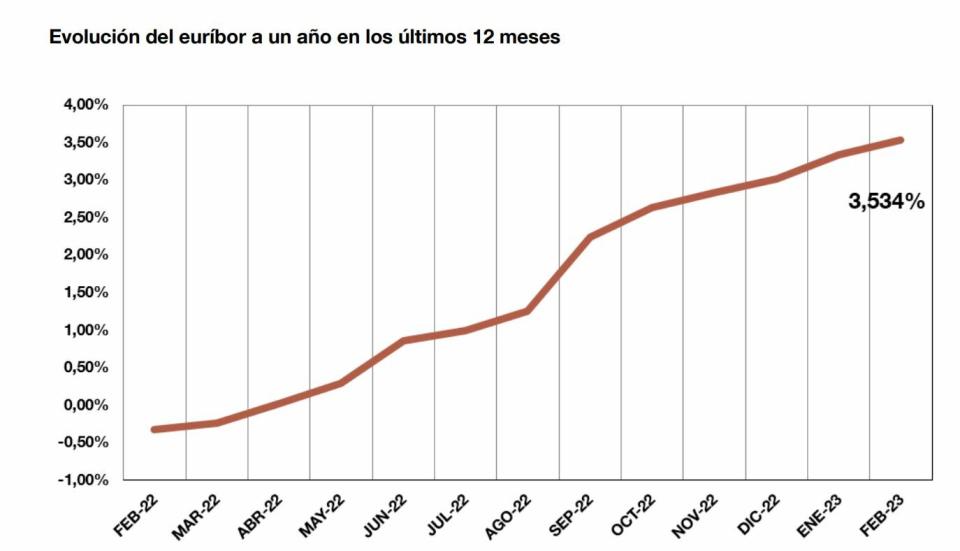A couple of weeks ago we talked about the vertiginous rise that was proliferating in the Euribor on account, not only of the increase in the amount of interest rates, but of the maintenance of that trend over time. The fight against inflation comes first, ECB President Christine Lagarde said last Thursdayafter raising rates in the euro area by 50 basis points despite the situation in some markets, which, in the Spanish case, they have seen no less than 25,000 million euros vanish from the capitalization of the banks.
But those deep falls, too They have reduced this rise in the Euribor to close to the 4% that it was already caressing on March 9 the main indicator for calculating mortgages in Spain. We are talking about a round trip Euribor, which was already stopping the continuous escalation on Friday the 10th with the problems that came from the regional banks of the United States. That stop became, last Tuesday, a plummeting fall of the indicatorup to close to 3.51% daily, a level that the indicator had not marked since last month.
In that roller coaster mode, we have seen how Thursday arrived, in a new fall to levels of 3.359%, the lowest until then in 12 months in one day, by far, so far this month to rebound in a New Black Friday, up to 3.38%. All of this lowers the monthly average for the week to 3.754%.
And it is that, after closing a February with an average of 3.534%, for an indicator that marked a geometric progression that has resulted in an increase close to 3.87% in the last year. In the translation into the money it costs an average mortgagee, after those fourteen months of uninterrupted rise of the indicator from negative levels, since April 2022, We are talking about 2,300 euros per month, for a 25-year mortgage, with a differential of one point and a capital requested in the loan of 100,000 euros.

Although the truth is that this stop on the road has not broken an upward trend that already marks, in these first fifteen days of the month, an average of 3.824%, despite having slightly broken the ascent. And we must not forget that what we are talking about is an annual average, which continues to rise despite the ups and downs and volatility.
Besides, after the rate hike of 50 basis points in the euro area, which leaves the ECB’s key rate at 3.5%it is normal for the Euribor to resume this upward path, which will break the estimated forecasts for 4% throughout the year, and only in the first months of the year, something in which a large number of mortgage analysts agree.
Because the ECB does not hide the fact that the strength of inflation prevails, and interest rates will continue to be raised among the 19 countries of the single currency to combat it.
And therein lies the quiz of the question right now: up to what level of rise can the European Central Bank reach to control inflation with rates throughout the year, without ending up having a strong impact on the economy, whose immediate effects we see in the Euribor and, therefore, in the strangulation of the purchasing power of families, already more than diminished with inflationwhich, for example, makes the price of food 16% more expensive, the most common daily expense in homes.
From Fotocasa, it is indicated, in their latest report, they highlight that The percentage of the year-on-year increase in the mortgage payment would rise to 48% if the Euribor reached 4% during this year, something closer and closer.
This would mean a monthly disbursement that would range, depending on the amount of the loan, between 260 and 610 euros per month, which would imply an increase in one year that would oscillate between 3,100 euros and 7,300 more per year. And they highlight, also from Fotocasa, that, for each point of increase in the Euribor, the mortgage becomes more expensive by 1,000 euros per year.


